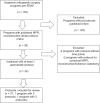Quality and Variability of Online Available Physical Therapy Protocols From Academic Orthopaedic Surgery Programs for Medial Patellofemoral Ligament Reconstruction
- PMID: 31309124
- PMCID: PMC6607570
- DOI: 10.1177/2325967119855991
Quality and Variability of Online Available Physical Therapy Protocols From Academic Orthopaedic Surgery Programs for Medial Patellofemoral Ligament Reconstruction
Abstract
Background: Unlike the literature on anterior cruciate ligament reconstruction, studies on medial patellofemoral ligament (MPFL) reconstruction lack evidence-based guidelines regarding postoperative rehabilitation. An effective postoperative protocol may contribute greatly to a successful outcome following MPFL reconstruction, yet the quality and variability of these published protocols remain unknown.
Purpose: To assess the quality and variability of MPFL rehabilitation protocols publicly available on the internet and associated with US academic orthopaedic programs.
Study design: Systematic review.
Methods: All available isolated MPFL reconstruction rehabilitation protocols from US academic orthopaedic programs participating in the Electronic Residency Application Service were collected and included in this review. These protocols were evaluated for inclusion of various rehabilitation components, the timing of suggested initiation of these activities, and whether the protocol used evaluation-based guidelines.
Results: A total of 27 protocols were included. Of these, 25 (93%) recommended immediate postoperative bracing. Time to initiation of full weightbearing ranged from 2 to 8 weeks. The most common strengthening exercises endorsed were quadriceps sets (89%), straight-legged raise (85%), and leg press (81%). The most common proprioception exercises endorsed were balance board (41%), single-legged balance (41%), and TheraBand control (33%). The median time suggested to return to play was 17 weeks. No functional test appeared in the majority of the protocols. Of the 27 protocols, 20 (74%) used evaluation-based guidelines.
Conclusion: There is substantial variability in content and timing across rehabilitation protocols following MPFL reconstruction. This lack of clear guidelines can cause confusion among patients, therapists, and surgeons, leading to suboptimal patient outcomes and making it difficult to compare outcomes across the literature.
Keywords: knee; ligaments; physical therapy; rehabilitation.
Conflict of interest statement
One or more of the authors has declared the following potential conflict of interest or source of funding: S.M.S. has received consulting fees from Medical Device Business Services and Pfizer and has received hospitality payments from Stryker. AOSSM checks author disclosures against the Open Payments Database (OPD). AOSSM has not conducted an independent investigation on the OPD and disclaims any liability or responsibility relating thereto.
Figures








Similar articles
-
Rehabilitation variability following medial patellofemoral ligament reconstruction.Phys Sportsmed. 2018 Nov;46(4):441-448. doi: 10.1080/00913847.2018.1487240. Epub 2018 Jul 2. Phys Sportsmed. 2018. PMID: 29888637
-
Online Rehabilitation Protocols for Medial Patellofemoral Ligament Reconstruction With and Without Tibial Tubercle Osteotomy Are Variable Among Institutions.Arthrosc Sports Med Rehabil. 2021 Jan 30;3(2):e305-e313. doi: 10.1016/j.asmr.2020.09.018. eCollection 2021 Apr. Arthrosc Sports Med Rehabil. 2021. PMID: 34027436 Free PMC article.
-
Online Physical Therapy Protocol Quality, Variability, and Availability in Achilles Tendon Repair.Foot Ankle Spec. 2019 Feb;12(1):16-24. doi: 10.1177/1938640017751185. Epub 2018 Jan 8. Foot Ankle Spec. 2019. PMID: 29310456
-
Return-to-Play Guidelines After Medial Patellofemoral Ligament Surgery for Recurrent Patellar Instability: A Systematic Review.Am J Sports Med. 2018 Aug;46(10):2530-2539. doi: 10.1177/0363546517713663. Epub 2017 Jul 5. Am J Sports Med. 2018. PMID: 28678520
-
Inconsistencies in Reporting Risk Factors for Medial Patellofemoral Ligament Reconstruction Failure: A Systematic Review.Am J Sports Med. 2022 Mar;50(3):867-877. doi: 10.1177/03635465211003342. Epub 2021 Apr 29. Am J Sports Med. 2022. PMID: 33914648
Cited by
-
Meta-Analysis of Knee Joint Function Recovery after Anterior Cruciate Ligament Reconstruction by Accelerated Rehabilitation Surgery.Comput Intell Neurosci. 2022 Jun 29;2022:5085143. doi: 10.1155/2022/5085143. eCollection 2022. Comput Intell Neurosci. 2022. Retraction in: Comput Intell Neurosci. 2023 Jul 26;2023:9893414. doi: 10.1155/2023/9893414. PMID: 35814551 Free PMC article. Retracted.
-
Rehabilitation and Return to Sport After Medial Patellofemoral Complex Reconstruction.Arthrosc Sports Med Rehabil. 2022 Jan 28;4(1):e133-e140. doi: 10.1016/j.asmr.2021.09.030. eCollection 2022 Jan. Arthrosc Sports Med Rehabil. 2022. PMID: 35141545 Free PMC article.
-
Analysis of Hemodynamic Changes After Medial Patellofemoral Ligament Reconstruction.Sports Med Int Open. 2022 Apr 4;6(1):E25-E31. doi: 10.1055/a-1807-8549. eCollection 2022 Jan. Sports Med Int Open. 2022. PMID: 35502361 Free PMC article.
-
Protocols of rehabilitation and return to sport, and clinical outcomes after medial patellofemoral ligament reconstruction with and without tibial tuberosity osteotomy: a systematic review.Int Orthop. 2022 Nov;46(11):2517-2528. doi: 10.1007/s00264-022-05480-4. Epub 2022 Jun 15. Int Orthop. 2022. PMID: 35701590
-
Return to Play Considerations After Patellar Instability.Curr Rev Musculoskelet Med. 2022 Dec;15(6):597-605. doi: 10.1007/s12178-022-09792-1. Epub 2022 Nov 11. Curr Rev Musculoskelet Med. 2022. PMID: 36367684 Free PMC article. Review.
References
-
- Ahmad CS, Brown GD, Shubin Stein BE. The docking technique for medial patellofemoral ligament reconstruction: surgical technique and clinical outcome. Am J Sports Med. 2009;37(10):2021–2027. - PubMed
-
- Ardern CL, Webster KE, Taylor NF, Feller JA. Return to sport following anterior cruciate ligament reconstruction surgery: a systematic review and meta-analysis of the state of play. Br J Sports Med. 2011;45(7):596–606. - PubMed
-
- Baltaci G, Harput G, Haksever B, Ulusoy B, Ozer H. Comparison between Nintendo Wii Fit and conventional rehabilitation on functional performance outcomes after hamstring anterior cruciate ligament reconstruction: prospective, randomized, controlled, double-blind clinical trial. Knee Surg Sports Traumatol Arthrosc. 2013;21(4):880–887. - PubMed
Publication types
LinkOut - more resources
Full Text Sources

